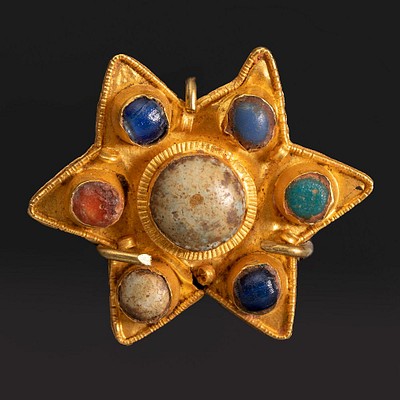ANTONIO DEL CASTILLO Y SAAVEDRA (Cordoba, 1616 - 1668) "The fall of Christ with the Cross, during Calvary". Oil on canvas. Relined.
Lot 75
About Seller
Setdart Auction House
Carrer Aragó 346
Barcelona
Spain
Setdart Subastas was born in 2004 and is currently the first online art auction in Spain with solidity, prestige and reliability guaranteed by our more than 60,000 users. Setdart has a young, dynamic and enterprising team ready to successfully manage the purchase and sale of art works through custom...Read more
Estimate:
EUR€10,000 - EUR€12,000
$10,752.69 - $12,903.23
Absentee vs Live bid
Two ways to bid:
- Leave a max absentee bid and the platform will bid on your behalf up to your maximum bid during the live auction.
- Bid live during the auction and your bids will be submitted real-time to the auctioneer.
Bid Increments
| Price | Bid Increment |
|---|---|
| EUR€0 | EUR€10 |
| EUR€200 | EUR€25 |
| EUR€500 | EUR€50 |
| EUR€1,000 | EUR€100 |
| EUR€3,000 | EUR€200 |
| EUR€5,000 | EUR€500 |
| EUR€10,000 | EUR€1,000 |
| EUR€20,000 | EUR€2,000 |
| EUR€50,000 | EUR€5,000 |
About Auction
By Setdart Auction House
Dec 21, 2021
Set Reminder
2021-12-21 07:30:00
2021-12-21 07:30:00
America/New_York
Bidsquare
Bidsquare : Córdoba: 2,000 Years of Art
https://www.bidsquare.com/auctions/setdart-auction-house/c-rdoba-2-000-years-of-art-8049
Setdart Auction House sofia@setdart.com
Setdart Auction House sofia@setdart.com
- Lot Description
ANTONIO DEL CASTILLO Y SAAVEDRA (Cordoba, 1616 - 1668) "The fall of Christ with the Cross, during Calvary". Oil on canvas. Relined. Presents faults and repainting. It conserves frame of epoch with faults in the gilding. Measurements: 64.5 x 46 cm; 120 x 71 cm (frame). The work stands out for the expressiveness of the scene, and the mastery of the author to capture a specific moment, reflecting the hustle and bustle and the drama of the events that took place. The scene depicted here, which would later give rise to the iconography of the Holy Face, typical of devotional painting, is an episode that occurred during the Passion of Christ, when on the way to Calvary a woman took off her veil to wipe the face of the Messiah with it. The image of the face of Jesus Christ was imprinted on the linen handkerchief, and it was miraculously preserved through the centuries, becoming an object of worship. The woman would later be called Veronica, whose etymology derives from the Latin "verum" (true) and the Greek "eikon" (image). Antonio Castillo is considered the father of the Cordovan school, known for his work as a painter, he was also a polychromator and designer of architectural, decorative and goldsmith projects. He was the son of Agustín del Castillo, a little known painter from Llerena (Extremadura) whom Palomino describes as "an excellent painter". It is also believed that he may have trained as a polychromator in Calderón's workshop. However, he was orphaned when he was only ten years old, in 1626, and went on to develop his training in the workshop of another painter of whom we have no news, Ignacio Aedo Calderón. Although there is no real evidence of this, it is believed that he may have arrived in Seville, where, according to Palomino, he entered Zurbarán's workshop. This has been corroborated by the stylistic influence of the master from Extremadura that historians have seen in Castillo's work. However, in 1635 he was back in his native Cordoba, where he married and settled permanently, to finally become without discussion the most important artist of the city. His fame and quality earned him important commissions, including religious altarpieces, portraits and medium-sized series. He was also the teacher of outstanding Cordovan painters of the following generation, such as Juan de Alfaro y Gámez. Regarding his language, Antonio del Castillo did not develop an evident evolution in his work, although towards the end of his life a more softened language can be appreciated, and he kept away from the baroque novelties of other contemporary painters. However, like the rest of his contemporaries, he was seduced by the novelty of Murillo's work, and in his last years he would introduce the Venetian chromatic softness of the Sevillian master. Today, examples are kept in the Prado Museum, the Hermitage in St. Petersburg, the J. Paul Getty in Los Angeles, the Louvre, the Metropolitan in New York, etc.
- Shipping Info
-
In-house shipping available. Please inquire at admin@setdart.com.
-
- Buyer's Premium



 EUR
EUR CAD
CAD AUD
AUD GBP
GBP MXN
MXN HKD
HKD CNY
CNY MYR
MYR SEK
SEK SGD
SGD CHF
CHF THB
THB
















